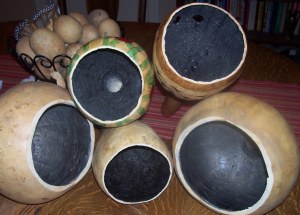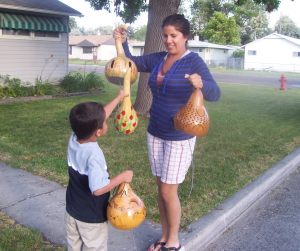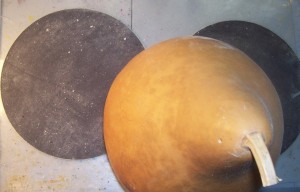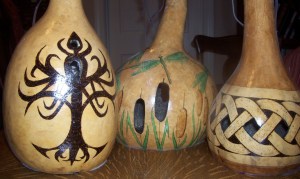Tags
cutting gourds, drum head, gourd tips, gourds, obsession, Ron Swank, sanding gourds, thunder drums
This season’s color obsession is purple and turquoise. I pick it to sew with. I wear it. I’d decorate with it if I was into redecorating my house. Last season it was other colors. Next season it will be still other colors.
I do the same obsessing with gourds. I’ve gone through obsessions with Art Nouveau designs, Native American designs, Celtic designs, horses and wolves. My latest obsession is unlike the others. It isn’t any kind of design. The obsession centers around the thunder drum. A thunder drum is a gourd with the bottom cut off so a drum head and spring can be attached. When the spring is wiggled, it vibrates the drum head, which in turn creates sound waves inside the gourd. The gourd amplifies the waves and releases it through other holes in the gourd and sounds like thunder. Think cello or bass. It is so amazing.
Each drum reverberates differently. There are many variables that make up the drum’s tone. such as: the size of the gourd, the size of the drum head or opening, the shape of the gourd, the placement, shape, and size of the holes in the drum, and the smoothness of the inside of the gourd. I was so intrigued with the differences in the sounds, I asked Becca Chavarria, a friend, a music student, and cellist at a local university to analyze them. Even she couldn’t predict why each sounded the way is does. The best theory so far has to do with the size of the drum head, but there is more to it than that.
So how do you make one of these fascinating gourd creations? You can order detailed and professional instruction along with the drum heads and springs from Ron Swank at http://www.risingsunflowerflutes.com/. Or you can do what I did, order the supplies, study a drum that was already made, and then go figure it out as you go.
Here are a few pointers that I have learned by inspecting completed thunder drums and asking questions.
– Pick a sturdy, thick walled gourd. It will be banged around a bit when it is finished.
-The bottom of the drum has to be cut and sanded absolutely smooth and flat. My saw and Dremel didn’t work so I got a sticky backed sanding pad that I attached to a solid surface. I rub the cut part of the gourd over it in a circular motion to get it absolutely smooth and flat.
-The inside of the gourd needs to be fairly smooth so the sound doesn’t become muffled.
-There has to be a hole or holes somewhere on the gourd other than the bottom to let the sound out. Holes that are too large decreases the depth of the sound. Plan your hole or holes when you do your design. I use a tiny keyhole saw that uses an Exacto blade handle or a mini jig saw to cut the hole. You can even use a cutter bit or drill bit with your Dremel to gouge out the shape. An emery board, the kind you use for your finger nails, words great to smooth the edges.
-A hanger cord needs to be attached before the drumhead is put on. The cord need to be pretty hardy, like leather or parachute cord since it will be hard to replace after the drumhead is on.
-Dark paint on the inside looks nice and will hide blemishes if you look into the holes. I spray paint it before I cut the extra holes to help prevent overspray onto the outside of the gourd.

I spray paint the inside black. Note the different thickness of the bottoms after they are sanded flat.
-I trace and cut the drumhead before I attach it. Other’s might find it easier to cut it afterwards. The drum head is best attached with an industrial strength super glue. I use CA Thick that can be found in woodworking shops.
-Watch the video by Ron Swank on how to heat shrink the drumhead and attach the spring. The link to the video can be found on his website shown above. Mine doesn’t always work like his, so sometimes I just keep at it until I have the look and feel I want. I do have to say I have ruined a couple trying to get it right. Once you have this last step done, you can finally hear what the drum will sound like.
-You will notice I gave no advice on how to design the gourd, the methods of putting on your design, or finishing the gourd. It is those things that make the thunder drum uniquely yours.
One of the nice things about this new to continue using the skills I developed with my old obsessions. I also get to continue adding new ones, like my newly emerging skill of chip carving. I wonder if that will become my next obsession?








Interesting.
LikeLike
They really are fun. They are intriguing.
LikeLike
Thanks for sharing this. One day I will order one from you! I love to drum. Sandi
LikeLike
Thanks Sandy. You need to come and visit at the Market. I’d love to show them to you.
LikeLike
What is the material that is used for the drum head, it would be nice to know what you are working with, to know if a mask is needed or not. Where can I find this material, Thank you in advance for the information.
LikeLike
Hello, love the post! I saw the mylar at Joann’s but I was curious where you got your springs from? I do all sorts of gourd art and am excited to try a Thunder Drum!
LikeLike
Robin, I get my supplies from Ron Swank. He is the one you came up with the idea of a gourd thunder drums. I also use a poly-carbonate for the drum head. You can order both the springs and the poly-carbonate from him at http://www.risingsunflowerflutes.com/. He is a wonderful person and so helpful. Enjoy trying these.
LikeLike
I have taped coarse sandpaper onto a board to level the bottom of gourds…but I dug out my palm sander and am using that with 80 or 120 grit pads. So much easier on my arms and shoulders! Gourds are addicting, aren’t they?
LikeLike
They certainly are. I will have to try the palm sander. It sounds like it might just be easier. thanks for the suggestion.
LikeLike
Do you cut the drum membrane the size of the opening or do you have to make it bigger? Does it shrink when you use the heat gun on it?
LikeLike
I cut the membrane to the exact size and shape of the gourd bottom. I then use super glue to attach it to the gourd and let it dry completely. When it is dry, I use a heat gun to shrink the membrane going around the edge then into the center. When the membrane is cool, I pierces the center of the now drum head and attach the coil.
LikeLike